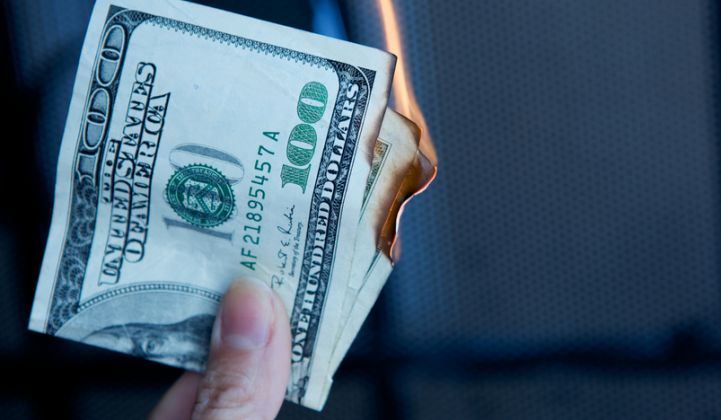The federal Investment Tax Credit is arguably America’s most important solar policy. This 30 percent tax credit spurred 1,600 percent annual growth since its implementation in 2007 and turned solar into an economic engine.
But the ITC is only authorized at 30 percent through 2016 before falling to 10 percent thereafter (for non-residential systems), and federal gridlock leaves its extension in doubt. America’s wind industry has suffered boom-and-bust cycles from Production Tax Credit reauthorization uncertainty, leaving analysts to ask if solar will suffer the same fate.
So here’s a proposal: let’s prevent a tumultuous future by reducing the ITC to 10 percent in 2017 and letting it expire in 2018. It may seem odd for a solar CEO to call for such a move, but we won’t need the ITC if we’re given a smooth glide path to prepare as an industry.
Consider a scenario after the 2016 elections, in which a lame-duck White House and the U.S. Senate fully extend the ITC for six months, providing continuity for solar developers while allowing the new government to take shape. Then, the ITC is lowered to 10 percent at the end of 2017, scheduled to end on December 31, 2018, and all projects started by the end of each calendar year qualify for that year’s full credit.
Precedent exists for this model in the California Solar Initiative, which provided incentives for rooftop solar starting in 2007 with a goal of installing 2,000 new megawatts by 2016. But California’s ending the incentives this year, well ahead of schedule, and the state’s solar industry is growing faster than ever. Why?
The answer’s simple: regulators volumetrically reduced payments at installation milestones as the industry matured, letting market forces direct incentives, rather than artificial inputs.
This measured decline is important. Consider the ongoing Chinese solar panel import tariff fight. Developers were only given a few months' notice before the U.S. Commerce Department imposed tariffs, hardly adequate time to react.
Industries are typically given time to prepare, but in this case, tariffs were imposed and developers immediately faced new economics on projects already under development. Even the nuclear industry was given several years to react to new regulations after the Fukushima disaster.
Without domestic manufacturing capacity, tariffs place solar developers at barely a net economic advantage, even with the ITC. On foreign projects, my company buys panels at around 55 cents per watt, but on projects within the U.S., we’re paying almost 75 cents -- an extra 20 cents/watt.
If a solar project averages $1.50/watt, the ITC provides approximately 50 cents/watt, but adds extra costs for imports or U.S.-made panels, and projects only receive 30 cents/watt of the ITC’s intended effect.
Import tariffs incentivize domestic manufacturing, and this is starting to happen: SolarCity is building a plant in New York state and foreign firms will establish manufacturing in the U.S. and Mexico next year to meet demand across North America and Latin America.
But even with increased domestic manufacturing, U.S.-made panels would still be more expensive than Chinese-made panels. Initial estimates place them in the high 60 cent/watt range, meaning developers will still face a financial crunch.
Reducing import tariffs would cut incentive reliance, but even if they stay in place, solar’s improving economics provide another reason to look beyond the ITC. Average American retail electricity prices have risen from 7.61 cents per kilowatt-hour in 2004 to 10.52 cents per kilowatt-hour in September 2014, according to the U.S. Energy Information Administration.
Meanwhile, solar keeps getting cheaper. International competition, technology innovations and new investment have lowered project costs 45 percent since 2012, according to the Solar Energy Industries Association. And the National Renewable Energy Laboratory forecasts that double-digit annual declines will continue at least several more years.
Rising power prices and falling project costs mean distributed solar is approaching grid parity with fossil fuels. Deutsche Bank estimates solar will soon hit grid parity in at least 36 states, even if the ITC drops to 10 percent.
The financial sector can also chip in. America has robust capital markets, and as more banks invest in solar, they improve project economics through competitive financing, compensating for higher capital costs.
Post-ITC, solar developers may find it easier to bring in debt financing on a project and increase levered returns to investors. The ITC attracts investors by reducing project costs and adding tax benefits, but complicates the deal by adding a tax equity investor to the equation. As solar costs fall, projects can be packaged as simplified traditional investments -- debt and equity secured by the asset and long-term returns.
In lieu of import tariffs, policymakers could also boost domestic manufacturer competitiveness through “Made in America” local sourcing rules. For context, the Brazilian Development Bank requires local components for renewable energy projects in order to secure loans at favorable rates, and India just announced it is providing hundreds of millions to fund new solar projects using Indian-made panels.
America’s solar industry still needs an ITC, at least today, but we must empower developers to be competitive without subsidies. It won’t happen overnight, but smart policy steps and a predictable wind-down process will complement industry trends to prevent volatile market contractions.
So let’s push for a smooth end to the ITC as our solar industry diversifies and becomes more efficient, creating a situation in which American solar stands on its own, without federal subsidies.
***
Camilo Patrignani is the CEO of Greenwood Energy, an engineering, procurement and construction firm focused on the clean energy sector.



